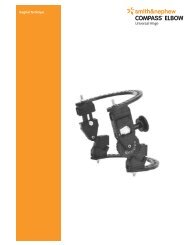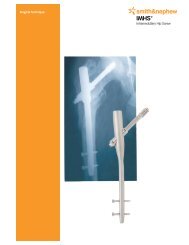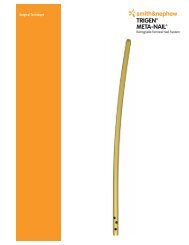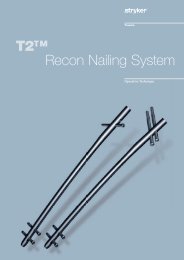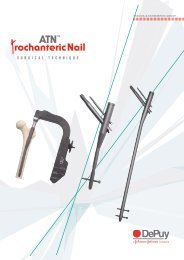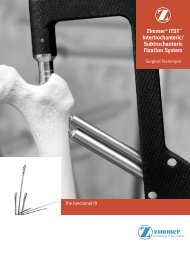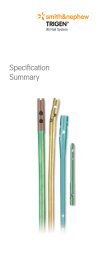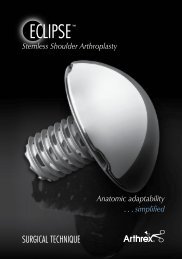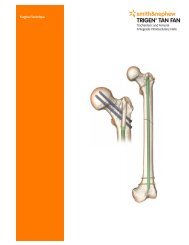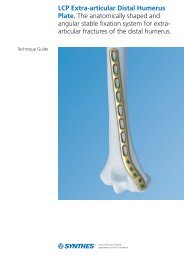You also want an ePaper? Increase the reach of your titles
YUMPU automatically turns print PDFs into web optimized ePapers that Google loves.
10<br />
SURGICAL TECHNIQUE<br />
Distal Humerus Plates by Shawn O’Driscoll, Ph.D., M.D.<br />
This section offers <strong>Acumed</strong>’s suggested method for implanting the Distal Humerus Plates using Tap-Loc Technology. For specific questions<br />
not addressed here, please contact your local <strong>Acumed</strong> representative or <strong>Acumed</strong> at 888.627.9957.<br />
Step 1: Articular Fragment Reduction<br />
The articular fragments, which tend to be rotated toward each<br />
other in the axial plane, are reduced anatomically and provisionally<br />
held with .045” smooth K-wires (WS-1106ST). It is essential that<br />
these wires be placed close to the subchondral level to avoid<br />
interference with later screw placement, and away from where<br />
the plates will be placed on the lateral and medial columns<br />
(see Step 2). One or two strategically placed wires can then be<br />
used to provisionally hold the distal fragments in alignment with the<br />
humeral shaft.<br />
Step 3: Initial Proximal Screw Placement<br />
Insert a 3.5mm screw into a slotted hole of each plate proximal<br />
to the fracture site. Loosely tighten, allowing some freedom for<br />
the plate to move proximally during compression later. (Because<br />
the undersurface of each plate is tubular in the metaphyseal and<br />
diaphyseal regions, the screw in the slotted hole only needs to<br />
be tightened slightly to provide excellent provisional fixation of<br />
the entire distal humerus.) Bone taps (MS-LTT27/35) are recommended<br />
for patients with dense bone.<br />
Step 2: Plate Placement and Provisional Fixation<br />
The selected medial and lateral plates<br />
are placed and held apposed to the<br />
distal humerus, while one smooth<br />
2.0mm K-wire (WS-2009ST) is inserted<br />
through hole #2 (numbered from distal<br />
to proximal) of each plate through the<br />
epicondyles and across the distal fragments<br />
to maintain provisional fixation.<br />
These 2.0mm wires are left in place<br />
until after Step 7 to simplify placing the<br />
locking screws in the distal fragments.<br />
The distal tap locking screws are able to<br />
be angled up to 20° in any direction.<br />
A tap screw angle guide (MS-TAG20) is<br />
included in the system to verify proper<br />
angulation prior to inserting the 2.0mm<br />
wires, which will later be replaced with<br />
locking screws. Place the angle guide<br />
next to the plate hole when inserting<br />
the wire to verify that the angle is equal<br />
to or less than 20°.<br />
A targeted drill guide (PL-CLAMP) is<br />
available in the system for accurate<br />
placement of the 2.0mm wires and<br />
future distal screws. Place the 2.0mm<br />
cannula (PL-20CLAMP) through the<br />
drill guide and into the plate hole. The<br />
opposing end of the guide is placed at<br />
the desired exiting point of the wire.<br />
A 2.8mm cannula (PL-28CLAMP) is<br />
also available for accurate drilling and<br />
placement of 3.5mm screws in later steps.



